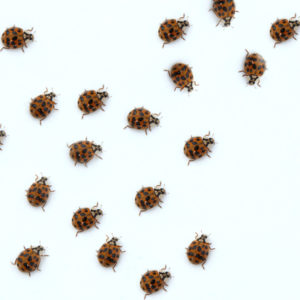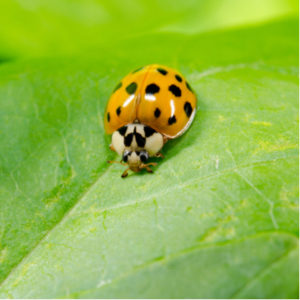Prepare for a Winter Infestation
Those pesky little beetles that look like ladybugs are coming. In the months leading up to fall, Asian lady beetles begin to leave summer feeding sites in search of safe places to spend the winter. As Asian lady beetles seek out shelter, they seek protection inside and outside buildings, including your business and home. They congregate in attics, ceilings, and walls while seeking protection and warmth for the winter.
They tend to wait to move until after periods of colder weather when the sun comes out and are drawn to sunny exterior walls and color contrasts. This means you will probably find them around window sills where lighter window trims meet a darker color. Houses and commercial buildings near wetlands, forests, or fields tend to have more Asian lady beetle infestations. The worst part about Asian beetles? When stressed, they release a stinky, yellow substance. And, they can bite.
Where do Asian Lady Beetles Come From?
Due to their similarities in appearance, Asian lady beetles are often mistaken for ladybugs. While ladybugs are native to the United States, Asian lady beetles were brought over to the U.S. by the Department of Agriculture in the 1960s to naturally control pest populations that were damaging crops. For many years, Asian lady beetles were successful in reducing the need for pesticides by eating aphids, plant-eating insects, and others that cause damage to crops.
Appearance of Asian Lady Beetle

Similar in appearance to the ladybug, the Asian lady beetle has two antennae, six legs, and two sets of wings. Adult Asian lady beetles are oval, convex, and about 1/4-inch long. Unlike the ladybug, which is red, Asian lady beetles are more of a tan or orange color. Asian beetles also have more spots than a ladybug, 19 to be exact. They also have small black markings on the white area of their head resembling an M or W.
What Does an Asian Lady Beetle Eat?
Because Asian lady beetles usually eat insects that feed on plants, farmers and gardeners typically welcome their presence. These plant-eating insects include:
- Aphids, small insects that feed on plant sap and can often harm plants.
- Spider Mites, smaller than aphids, these are soft-bodied plant sap eaters.
- Mealybugs, another plant sap eater that is white-colored.
- Mildew, pollen, and nectar.
- Any other small insect that is available.
Lifecycle of the Asian Lady Beetle

The Asian lady beetle goes through four stages of life. Adult females lay eggs in clusters or rows on the underside of trees, leaves, or crops. After three to seven days, the larvae hatch and begin searching for food. They are most active during the warm winter months and will seek shelter under rocks and logs and inside the walls of your homes. Up to 1,000 bugs at a time will congregate before finding warmth and hibernating. When early spring arrives, they awake and make their way out of your attic, walls, and baseboards. This is when you typically start finding one or two walking around, but make no mistake, where there is one, there are surely hundreds more out of plain sight.
Why Home Infestation is a Problem
While Asian lady beetles are not structurally destructive and will not lay eggs inside the home, if disturbed, they will stress and release a yellow, smelly substance from their joints. It’s used as a defense mechanism to defend itself from predators. They have also been known to become aggressive and bite humans and pets. The bite is usually nothing more than an annoyance.
Asian Lady Beetle Control in the Home
Once Asian lady beetles infiltrate your home, they typically return year after year. Pheromones released by past beetles are detected by future generations. They also tend to choose houses that are lighter in color and are close to wooded areas. The best way to prevent an infestation from occurring is by preventing them from entering in the first place. Pest Control Unlimited suggests caulking any gaps and cracks around the exterior of your home and seal doors, windows, and any openings around pipes. We also recommend having any damaged clapboards repaired or replaced.
Bug Extermination
At Pest Control Unlimited, we specialize in bug extermination. Our residential treatments include both one-time and Quarterly Program visits, depending on your needs and the state of your property. Our technicians also help seal up places where pests are getting in your home and provide other assistance to reduce the problem. Call us now at 888-649-9919 or request a quote.

